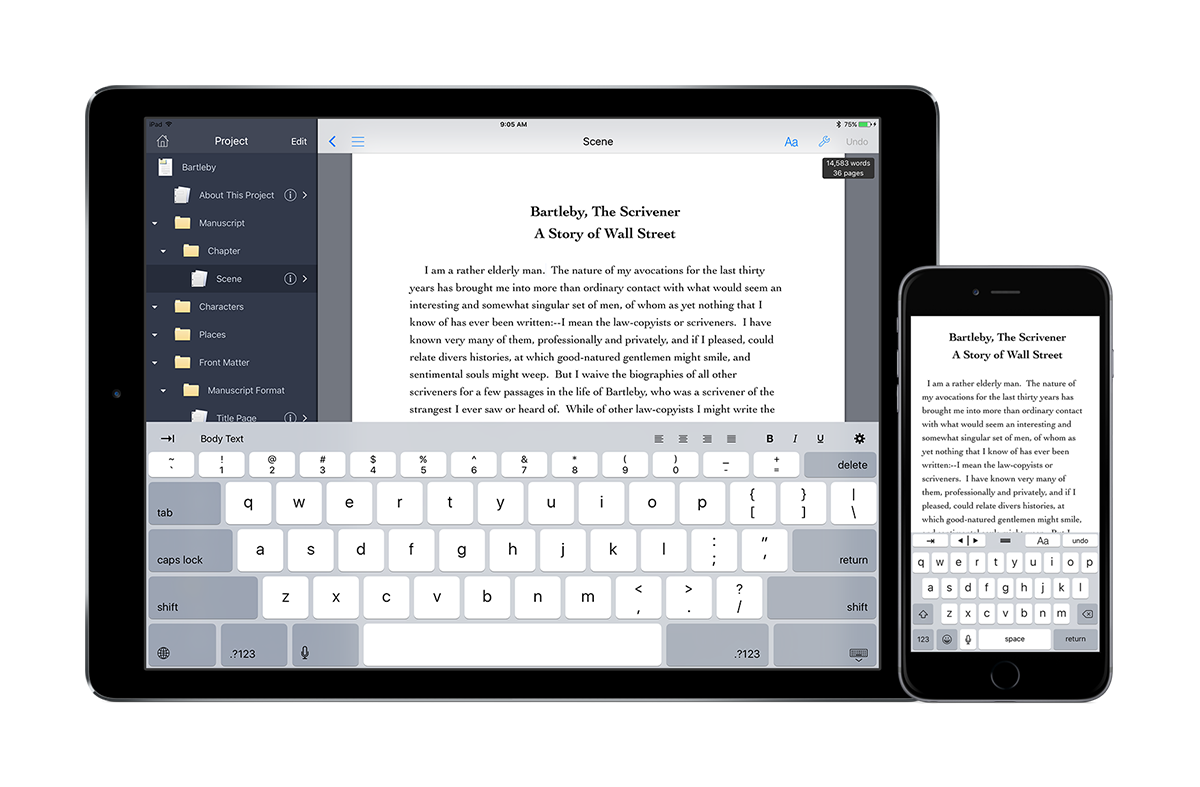Editing Scrivener Files with Storyist for iOS

As of version 3.1, Storyist for iOS can edit Scrivener files in addition to Storyist, Final Draft, Fountain, RTF, and plain text files.
The process is straight-forward:
- Install Storyist 3.1 or later for iOS on your iPad or iPhone.
- Configure Storyist to store files in iCloud Drive.
- Place your Scrivener files in the Storyist folder in your iCloud Drive folder on your Mac or PC. (Don’t create this folder yourself. iCloud will create it for you after you setup iCloud in Storyist for iOS.)
- Open the files in Storyist for iOS and edit them.
iCloud will keep track of the changes you make in Storyist and sync them to the cloud and from there to your Mac or PC. Similarly, when you edit the files in your iCloud Drive folder using Scrivener, iCloud will sync them to the cloud and then to your devices.
Things You Can Do
- Edit and format text. Storyist supports both draft mode and page mode and provides an inspector for font and paragraph formatting operations.
- Edit comments.
- Add and edit project (Scrivener) links.
- Add, reorganize, and delete items in the project (binder) view.
- Import and export files using iTunes, email, “send-to-app,” and the iOS 8 document picker.
Things You Can’t Do in This Version
- Edit index cards. Scrivener files don’t support outlining within a text file, so you won’t see file outlines or index cards in the project view like you will with Storyist, Final Draft, or Fountain files. However, all outline and index card information is preserved when you edit the file, and will be available to you when editing in Scrivener.
- Compile. Storyist doesn’t require a compile step since most Storyist users keep their manuscripts in a single file and use heading-level styles to indicate chapters or scenes. Storyist does preserve all compile settings when editing a Scrivener file, so you’ll still be able to compile your manuscript in Scrivener.
- Create new projects. Storyist for iOS doesn’t currently create Scrivener projects. You can, of course, create them in Scrivener and then sync it to your iOS device.
- Use tables or strikethrough. Storyist for iOS doesn’t support these features. Tables and strikethrough text formatting are not preserved when edited in Storyist.
Best Practices
- Close Scrivener when working on your file on another device. Scrivener modifies a file when opening it and again when closing it, even if you don’t make any changes yourself. This causes iCloud to sync the “changed” file to your devices. If you are editing the file on another device, this can result in sync conflicts. As described in this tech support article, it’s best to keep Scrivener closed when you’re editing the file on another device.
- Store files in iCloud, not Dropbox. Scrivener files are actually Apple file packages. Dropbox doesn’t support file packages very well at the moment (it treats them as folders, not files) so syncing of Scrivener files via Dropbox isn’t currently supported, though it may be in the future. Apple, of course, supports its file package spec just fine, so you’ll want to use iCloud instead.
- Prefer iCloud to Dropbox, Google Drive, or OneDrive for importing and exporting. Storyist uses the iOS 8 document picker to import and export files. Document pickers for a given cloud service are provided by their respective app. As of this writing (October 2015), the Dropbox, Google Drive, and OneDrive file pickers have issues with Apple file packages, so these cloud services don’t work well with Scrivener files. As with syncing, the iCloud document picker works just fine. Note that you can also use email and the “Open In” command to send projects to and from your iOS device.
- Prefer Smaller Projects. Mobile devices generally have slower processors and less memory than their desktop counterparts. While iCloud does a good job of syncing only the changed files, (which is a great help on slow networks), smaller projects use less disk space and open quicker.
- Use Fonts That Are Available on iOS. iOS offers fewer fonts than OS X or Windows does. If your project uses a font that is not available on your iOS device, the iOS font system will try to select a replacement that best matches the missing font. That replacement is often Helvetica. It is possible to add fonts to your iOS device, though, and there are some 3rd party apps that facilitate the process. You’ll find a good overview here.
Notes for Windows Users
- You can setup iCloud for Windows by following the instructions in Apple’s Set up and use iCloud for Windows tutorial.
- When copying your Scrivener project to the Storyist folder in your iCloud Drive folder, make sure you copy the entire .scriv folder, not just the .scrivx file that is inside the .scriv folder.
Known Issues in the Current Release (3.1.1)
- No known issues. If something is not working as expected, please send email to support@storyist.com and we’ll investigate.
